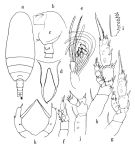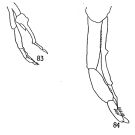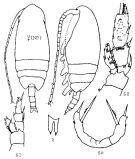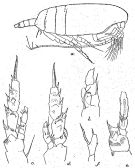|
|
 |
Fiche d'espèce de Copépode |
|
|
Calanoida ( Ordre ) |
|
|
|
Clausocalanoidea ( Superfamille ) |
|
|
|
Scolecitrichidae ( Famille ) |
|
|
|
Amallothrix ( Genre ) |
|
|
| |
Amallothrix paravalida Brodsky, 1950 (F,M) | |
| | | | | | | Syn.: | Amallothrix valida : Sars, 1925 (p.186, Pl.51); Sewell, 1929 (p.217, figs.F);
Scolecithricella paravalida : Tanaka, 1962 (p.73, figs.F, Rem.);
Scolecithricella (Amallothrix) paravalida : Vervoort, 1965 (p.68, Rem.); Scolecithricella sarsi : Tanaka, 1953 (p.133);
? Scolecithrix valens Farran, 1926 (p.263); ? Amallothrix valens : Rose, 1933 (1934 a) (p.12); Kovalev & Shmeleva, 1982 (p.84); Vyshkvartzeva, 1999 (2000) (p.235) | | | | Ref.: | | | Brodsky, 1950 (1967) (p.263, Descr.F, figs.F; Rem.: This species has been often confunded with Scolecithrix valida Farran, 1908 b (= Scolecithricella or Amallothrix valida ); Grice & Hulsemann, 1967 (p.16, 26, figs.M); Park, 1970 (p.507, 511, Rem.); Morioka, 1972 a (p.314); Bradford, 1973 (p.143); Bradford & al., 1983 (p.78, Rem.); Vyshkvartzeva, 1999 (2000) (p.235); Vives & Shmeleva, 2007 (p.736, figs.F,M, Rem.) |  issued from : O. Tanaka in Publ. Seto Mar. Biol. Lab., 1962, X (1). [p.74, Fig.144]. As Scolecithricella paravalida. Female (from Sagami Bay): a, habitus (dorsal); b, forehead (left lateral side); c, last thoracic segment and urosome (left lateral side); d, rostrum (dorsal view); e, Mx2; f, P1; g, P2; h, P3; i, proximal part of terminal spine of exopod of P3; j, P4; k, P5. Nota Female: - Cephalothorax about 2.05-2.91 times the abdomen length. - Head and 1st pediger segment fused, 4th and 5th thoracic segments incompletely fused, line of fusion visible from dorsal. - Postrerolateral corners of last thoracic segment slightly produced in lateral view. - Rostrum rami robust attenuate suddenly into fine filament at the distal half. - Urosome 4-segmented; Abdominal segments and caudal rami in the proportional lengths 34 : 24 : 21 : 8 : 13 = 100. - Genital segment not swollen ventrally. - Abdominal segments 1 to 3 fringed with fine teeth on the distal margin. - Caudal rami 1.7 times as long as wide; 2nd inner seta very long. - A1 23-segmented on the left side; 22-segmented on the right side; extend to the end of the 3rd abdominal segment. - A2 exopod 1.2 times as long as endopod. - Mx2 with 6 bud-like filaments of about equal in size, and 3 vermiform filaments on the endopod. - P1 with a long outer edge spine on the 2nd exopodal segment, exceeding the base of the spine on the 2nd segment. - P2 with the outer edge spine on the 1st exopodal segment, far longer in proportion to that of S. valida; terminal spine of exopod with 29 teeth; the teeth rather coarse, and connected by a sort of lamella but do not make fenestella. - P3 with 30 teeth on the terminal spine of exopod, and similar in structure to that of P2. - P4 with scattered spinules on posterior surface of the coxa; outer margin furnishede with short hairs; inner marginal seta rather long; terminal spine of exopod with 41 teeth. - P5 has a free segment attached to the 1-segmented basal segment; Distal segment with 1 inner marginal spine furnished with fine teeth arranged in a straight line. Apical spine rather delicate. Outer marginal spine located opposite to the inner marginal spine on the right leg and near to the apical spine on the left leg. Several spinules observed on posterior surface near the inner margin midway between the base of the inner marginal spine and distal border of the basal segment; these spinules entirely absent in Amallothrix valida Sars (1925)
|
 issued from : G.D. Grice & K. Huisemann in Proc. U.S. natn. Mus., 1967, 122 (3583). [p.52, Figs.83-84]. Male (from Indian Ocean): 83, P5; 84, left P5. Nota: The terminal segment of the left P5 has two rows of spines and a rounded lamella.
|
 Issued from : G.O. Sars in Résult. Camp. Scient. Prince Albert I, 69, pls.1-127 (1924). [Pl.LI, figs.22-28]. As Scolecithrix valida. Female (from W Canary Islands): 22, habitus (dorsal); 23, idem (lateral left side); ; 24, rostrum; 25, P2; 26, endopodal segments of P3; 27, endopodal segments of P4; 28, P5 (with intercoxal plate). Nota Female: Rostrum highly splitted, with apical filaments very short. - Head and 1st pedigeous segment fused, 4th and 5th pedigers fused; - Posterolateral corners of the last thoracic segment obtusely rounded. - Urosome slightly longer than 1/4 of prosome. - Genital segment slightly swollen ventrally, about as long as the two following segments together. - Caudal rami slightly longer than wide and not divergent. - A1 longer than the body, caudal rami included. - P2 with spine of the 1st exopodal segment strongly curved. - P5 segment of the same broad and distinctly curved; distal segment imperfectly separated from preceeding with a feeble line on the inner margin. 1 strong spine, a little tooth on the outer margin and 1 short inner spine at apex.
|
 Issued from : K.A. Brodskii in Calanoida of the Far Eastern Seas and Polar Basin of the USSR. Opred. Fauna SSSR, 1950, 35 (Israel Program for Scientific Translations, Jerusalem, 1967) [p.263, Fig.171]. Female (from NW Pacif.): habitus (dorsal and lateral left side); R, rostrum; S1, P1; S2, P2; S5, P5.
|
 issued from : R.B.S. Sewell in Mem. Indian Mus., 1929, X. [p.218, Fig.80]. As Amallothrix valida. Female (from S India): a, habitus (lateral right side); b, P1; c, P2; d, P3; e, P4 (basal portion and endopod); f, P5.
|
 issued from : O. Tanaka in Publ. Seto Mar. Biol. Lab., 1962, X (1). [p.74]. As Scolecithricella paravalida. Female: Proportional lengths of segments A1 on the left side. Noyr the remarkable seta and aesthetasc on the segments 3, 7, 9, 14, 18, and 25; segment 10 with a distal seta, and segment 15 with a distal spine;
| | | | | Ref. compl.: | | | Vives, 1982 (p.292); Yamaguchi & al., 2002 (p.1007, tab.1); Kuriyama & Nishida, 2006 (p.293, 299: Tab.II; p.309: Tab.III, fig.7, 10, vertical distribution, Rem.: p.313); Ikeda & al., 2006 (p.1791, Table 2); Homma & Yamaguchi, 2010 (p.965, Table 2); Homma & al., 2011 (p.29, Table 2, 3, 5, abundance, feeding pattern: detritivores) | | | | NZ: | 5 + 1 douteuse | | |
|
Carte de distribution de Amallothrix paravalida par zones géographiques
|
| | | | | | | | | | Loc: | | | G. of Guinea (off Ghana), off Mauritania, off W Canary Is., off Azores, ? Bay of Biscay, ? Medit. (Algiers' Bay), Indian (off S Laccadive Is.), Japan, Sagami Bay, off SE Hokkaido, Okhotsk Sea, Station Knot, Bering Sea (Aleutian Basin), S Aleutian Is. | | | | N: | 11 | | | | Lg.: | | | (1) F: 2,1; (16) F: 2,08; (22) F: 2,5; (117) F: 2,7; (1000) F: 2,5 ±0,2; {F: 2,08-2,70} | | | | Rem.: | méso-bathypélagique-abyssale.
Genre mal assuré.
? Cf. Amallothrix valens. Pour Park (1970) la synonymie ne fait pas de doute contrairement à Tanaka (1962) et Bradford & al. ( 1983). La distribution géographique de cette espèce est incertaine.
Voir aussi les remarques en anglais | | | Dernière mise à jour : 18/01/2021 | |
|
|
 Toute utilisation de ce site pour une publication sera mentionnée avec la référence suivante : Toute utilisation de ce site pour une publication sera mentionnée avec la référence suivante :
Razouls C., Desreumaux N., Kouwenberg J. et de Bovée F., 2005-2025. - Biodiversité des Copépodes planctoniques marins (morphologie, répartition géographique et données biologiques). Sorbonne Université, CNRS. Disponible sur http://copepodes.obs-banyuls.fr [Accédé le 02 décembre 2025] © copyright 2005-2025 Sorbonne Université, CNRS
|
|
 |
 |








